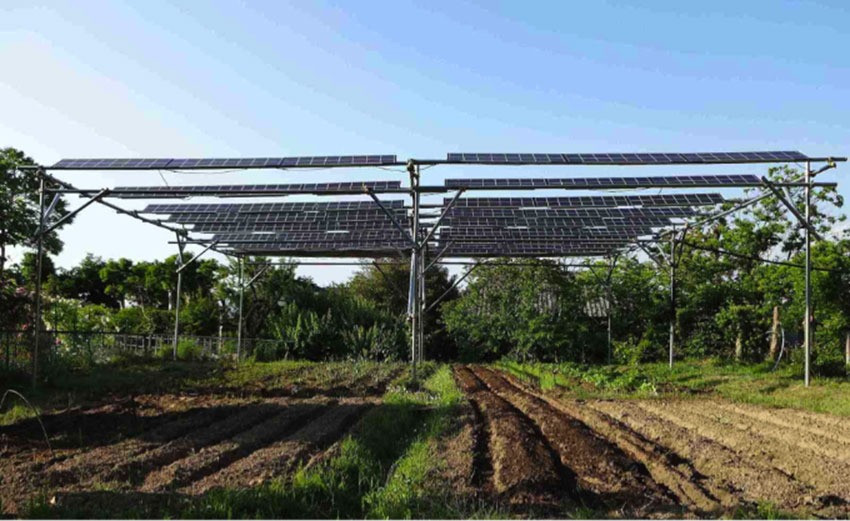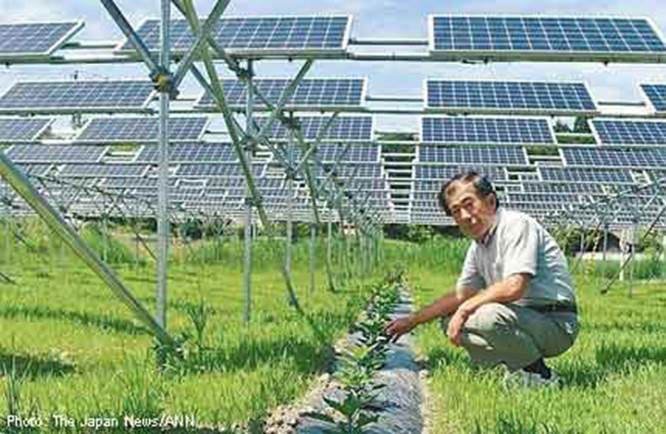Towards 100% Renewables
Revitalizing the farming sector for the next-generation and could provide more than enough electricity for the entire country Dr. Mae-Wan Ho
Farmers in Japan are taking advantage of new opportunities to generate electricity while growing crops. In April 2013, the Ministry of Agriculture, Forestry and Fisheries (MAFF) approved the installation of solar PV system on crop-producing farms, which was previously prohibited under the Agricultural Land Act, regardless of whether the land is productive or idle [1].
The practice of food and energy double-generation, known as “solar sharing” in Japan, was originally developed by Akira Nagashima in 2004. Nagashima, a retired agricultural machinery engineer, studied biology and learned of the light saturation point at which increase in the level of sunlight does not cause any further increase in the rate of photosynthesis. (Actually, only a small fraction of the incident sunlight is needed for plants to reach maximum rate of photosynthesis; too much light can be damaging, and plants have evolved mechanisms to protect themselves from being ‘sunburnt’; see [2] Harvesting Energy from Sunlight with Artificial Photosynthesis, SiS 43).
Nagashima came up with the idea of combining PV with farming. He devised and originally patented a special structure like a garden pergola, which was tested in fields with different crops and shading rates. The structures are made of pipes and rows of PV panels mounted above ground, and arranged at certain intervals to allow enough sunlight for photosynthesis. There is no concrete footing so the structures can be easily dismantled; the system is designed to allow adequate sunlight for crops and space for agricultural machinery to be used, as stipulated by MAFF guidelines.
According to Nagashima, the MAFF guidelines are to ensure that farmers remain farmers, and not to fully convert productive farmland into solar facilities. Based on his tests in the Chiba Prefecture, he recommends about 32 % shading rate. Farmers are required to report their annual crop cultivation, and if the amount cultivated on the solar-shared farmland falls below 80 %, they will be required to dismantle the PV system.
Makoto Takazawa, owner of the 34.4 kW Kazusatsurumai Solar Sharing Project in Chiba Prefecture said solar sharing can re-activate the declining farming sector. Farmers in Japan are suffering reduced farm revenues and lack of successors. Many small farmers are forced to take on a second job to make ends meet. Takazawa installed 348 PV panels on a small 750 square metre farm, mounted on pipes 3 metres from the ground. Under the solar panels, Takasawa’s father has cultivated peanuts, yams, eggplants, cucumber, tomatoes and taros, and cabbages during the winter. The vegetables are sold at a nearby street market and consumed by his neighbours.
The PV system produces 35 000 kWh a year and cost Takazawa about 12.6 m yen ($126 000) to install. He secured the first available FIT (feed-in-tariff) rate of 42 yen/kWh for 20 years, earning 1.6 million yen (~$16 ooo) annually, while making only 100 000 yen (~$1 000) from farming. “I hope this will attract young people to come back to the countryside” Takazawa said.

Solar sharing at Chiba on Takazawa’s farm (renewable energyworld.com)
The practice has since spread to other prefectures such as Aichi, Mie and Ibaraki [3].
In Aichi Prefecture, Tsuboi has designed and self-installed a 50 kW system over the growing citrus trees [1]. About 600 PV panels are installed in the 7.7 acres farm mounted on 5 metres high steel pipes. The citrus grown is a hybrid of mandarin and orange. Tsuboi has a second job; this year, he expects the PV system to bring 2.5 million yen (~$25 000) in additional income.
Is the structure stable and durable? Nagashima said that his systems even withstood strong winds and earthquakes during the Fukushima tsunami disaster of 2011. The systems are lightweight and the panels spaced out, allowing air to flow through, thereby reducing wind load. He suggested solar-shared farming for ranches in the United States. The solar panels would be especially suitable over grass pasture to provide shade for cattle or sheep, and also reduce irrigation as more moisture is retained.
Solar-shared faming may be appropriate for other regions such in Africa and Latin America, and the Middle East, where incident sunlight is intense, and water scarce.
Farmers in Fukushima Prefecture are also turning to solar- sharing. They are hoping to sell the power to help cover the losses from the nuclear crisis at Tokyo Electric Power Company’s Daiichi nuclear power plant. Solar panels are set up on the farmland, and farmers can use the money from the sale of the electricity generated to improve the farmland or to cover losses in come caused by the fear of radiation [3].
In Minami-Soma, the prefectural government has begun a model project. A 2 000 square metre farmland in the city’s Odaka district is designated for solar sharing. It is a “zone being prepared for residents’ return” where the level of radiation exposure is 20 millsieverts or less a year. A total of 500 solar panels have been installed 1.9 metres above ground. Under the panels, eggplants, chili pepper and other produce are grown on an sexperimental basis.

Solar sharing in Fukushima
Farmer Ichiro Hirata, 62, who owns the land said that his crops will not sell for the time being due to “groundless rumours of contamination.” But until prices recover, he can cover the loss by selling electric power.
An increasing number of Fukushima farmers are taking up the scheme. In addition to the model project in Minami-soma, Eko Ene Minami-soma Kenkyu Kiko, an incorporated foundation, plans a solar-sharing project on about 600 square metres of farmland, and expects about 1 million yen of annual revenue from the sale of electricity generated.
The town government of Aizubange in Fukushima Prefecture is also considering introducing the scheme as are some farmers in Sendai of Iwate Prefecture; an official in the government’s agriculture promotion division has received enquiries from farmers and from local agricultural committees.
Japan requires about 2.5 million acres of land to supply the entire country’s electricity with PV [1]. Under the solar-share scheme, it will take about 7 million acres of farmland to supply the same amount of electricity. Japan currently has more than 11.3 million acres of available farmland.
Solar sharing could well be a readily available alternative to artificial photosynthesis [2] in harvesting sunlight, as batteries for energy storage improve and come down in price [4] (Renewable Ousting Fossil Energy, SiS 60).
Before the industrial revolution, farmers provided both crops and energy in the form of firewood and charcoal to society, Nagashima said [1], solar-share farming will do the same again and revitalize the farming sector.
Article first published 16/10/13
Got something to say about this page? Comment
There are 5 comments on this article so far. Add your comment above.
Solar panel mounting structure Comment left 29th October 2013 02:02:07
nice...Solar panel mounting structure
Todd Millions Comment left 29th October 2013 17:05:49
I would be interested in any guttered measurements of dew condensing from these arrays,at given low tempture points and humidity levels.The 35% shading is similar to test sections done in US in 1970's at similar latitudes.The arrays shown don't seem to me suitable for cattle-fighting and rubbing.Testing with goats,sheep,llamas-alpacas ect may be a good first step.Do range(Berkshire)pigs-dig enough to cause concern?
Solar panel mounting structure Comment left 11th November 2013 20:08:15
amazing blog..Solar panel mounting structure
Abhi Roy Comment left 2nd December 2013 21:09:25
Solar power is a good resource in renewable energy area. Especially for farmers, solar panel and solar module mounting structure product is a great aid for them.
kishor Comment left 16th October 2015 15:03:26
Can the facility of both farming and solar farming in india?